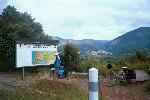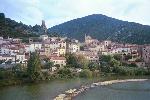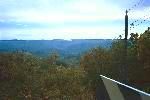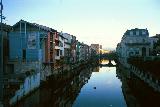The above quote got me into a lot of hot water this trip. We started to plan our trip last summer. I had no idea, while looking at my inadequate maps in Toronto, that there would be so much climbing.
Thursday October 8th Cessenon to St.Pons-de-Thomières 50.8 KM
 Just outside Cessenon. We would be climbing for several days. It was WINDY again. Really stiff, just like yesterday. And quite cold. But the scenery was great. We cycled up the L'Orb river valley passing beautiful towns and countryside the whole way. It was marvelous and wild and empty of people. The road had little traffic. We passed vineyard after vineyard that had been harvested of all their grapes but each field had a little hand written sign advertising "Haute Languedoc" honey for sale.
Just outside Cessenon. We would be climbing for several days. It was WINDY again. Really stiff, just like yesterday. And quite cold. But the scenery was great. We cycled up the L'Orb river valley passing beautiful towns and countryside the whole way. It was marvelous and wild and empty of people. The road had little traffic. We passed vineyard after vineyard that had been harvested of all their grapes but each field had a little hand written sign advertising "Haute Languedoc" honey for sale.
 The lovely town of Roquebrun on the L'Orb river. We stopped to have coffee here in the early morning. The town is only 12 Km from Cessenon and has two hotels and several restaurants. We could have stayed here the night before but all of the tourist brochures were very clear: "There are no hotels or restaurants in Roquebrun."
The lovely town of Roquebrun on the L'Orb river. We stopped to have coffee here in the early morning. The town is only 12 Km from Cessenon and has two hotels and several restaurants. We could have stayed here the night before but all of the tourist brochures were very clear: "There are no hotels or restaurants in Roquebrun."
We cycled all day so that we could get to St.Pons. This was important because the next day our route would take us further north into the wilds of the Haute Languedoc and further away from civilization. I knew we had to make a very steep climb first thing the next morning, after which we would have a 73 Km ride through extremely hilly country to get to the next town large enough to have a hotel.
Friday October 9th St.Pons-de-Thomières to Castres 60.7 KM
It was very cold when we woke up early that morning. It was overcast and something like 5º Celsius. It had also been raining sometime during the night, so in addition to the cold it was damp.
After breakfast we got off to an early start. It was so cold that the people looked at us as if we had lost our minds. I was wearing shorts and my customary flip-flops that I like for cycling. Elizabeth was dressed a little warmer but still looked like a road warrior. It was too cold to be on bicycle. A few minutes out of town we started our climb. It was 8:30 am. It was very steep, but we pushed on. Even though it was so cold, I soon took off my jacket and vest because I was sweating so much.
 A photo about ½ way into our climb just after leaving St. Pons-de-Thomières. This was the last we saw of St. Pons. I know it's not very clear, but if you look closely you can see it way down in the valley. From here we continued on climbing. In all we climbed over 2000 feet in 11 Km. It took just over two hours with an average speed of 4 Km an hour.
A photo about ½ way into our climb just after leaving St. Pons-de-Thomières. This was the last we saw of St. Pons. I know it's not very clear, but if you look closely you can see it way down in the valley. From here we continued on climbing. In all we climbed over 2000 feet in 11 Km. It took just over two hours with an average speed of 4 Km an hour.
We arrived in Castres at about 4:30. The ride was easier than I had imagined. After climbing all morning we had lunch in the small town of Anglés. I think we had only ridden about 27 Km at this point. After lunch our road seemed to even out and then....DOWNHILL. Lots of it. We literally flew along hardly ever climbing, hardly ever peddling. We even found a shortcut into Castres that an elderly gentleman and his wife suggested we take when we stopped to ask directions. Again we heard the telltale phrase, "Vous tombez la." Although this time it really meant what it said. "You'll fall there." There was so much downhill, it really was like "falling."

3 photos stuck together to create a panoramic view of the Canal at Castres.
 Castres.
After a quick visit to the tourist office we found the greatest place to stay, Hotel Le Perigord FF170 ($50.00 cdn). One of those family run places that wasn't even rated by the tourist bureau. It was run by a husband and wife who were about our age. She supervised in the kitchen and he looked after the clientele. He told us that he is still a serious cyclist and in summer logs about 300 Km a week.
Castres.
After a quick visit to the tourist office we found the greatest place to stay, Hotel Le Perigord FF170 ($50.00 cdn). One of those family run places that wasn't even rated by the tourist bureau. It was run by a husband and wife who were about our age. She supervised in the kitchen and he looked after the clientele. He told us that he is still a serious cyclist and in summer logs about 300 Km a week.
That evening we walked through town looking for a bar in which to have a drink and came across a lively little place that was having a soirée de Ricard (an anise flavored apéritif favored by many). The music was loud but the drinks were FF5 ($1.45 cdn) instead of the usual FF10. There were door prizes to be had (I got a plastic Ricard shot measurer) and there were free plates of mussels as well. The fellow who ran the affair was quite curious about are trip and kept shouting questions which I could barely hear above the music.
That night we decided to eat in our hotel restaurant. Elizabeth elected not to have a menu for a change. For 90FF ($26.00 cdn) she had just a main course of Chateaubriand with Cêpes (Porccini mushrooms). It was great. I went for the menu FF75 ($22.00 cdn) I started with a choice of crudités (from a big wagon that came to the table - I went back for more), followed by confit de canard (soft and falling off the bone - just perfect). Then baba au rhum for dessert. We were so full we had to decline the cheese.
Saturday October 10th Castres to Castelnaudary 62.7 KM
We left Castres at about 9:45 after confirming train schedules at the SNCF station in town. This threw my direction finding off a bit and we ended up on the very busy Route National. It took us about 15 Km of highway hell to sort ourselves out but we soon found more peaceful roads. (Elizabeth thinks they were too peaceful - they were also very hilly and she was becoming discouraged at this point.) After a couple of hours of climbing and descending, then climbing again we opted for one of the slightly larger D routes. Even so, there wasn't much traffic and I admit that I enjoyed that fact that there was not so much up and down to contend with.
After lunch we came to a small river. Elizabeth noticed the symbol of a scallop shell* set into an iron cross along side the edge of a path that followed the river. The path wasn't paved but it was too perfect. We followed it and it lead down stream under a canopy of trees that blocked out the sun and cast shadows on our route. The air was heavy with the smell of autumn. Birds chattered in the trees overhead and once or twice I thought I could hear the soft sound of distant footsteps and creaking ox carts making their way westward in another time. After an hour or so the path swerved sharply north and we found ourselves in sunlight once more.
|
|
|
|